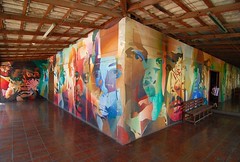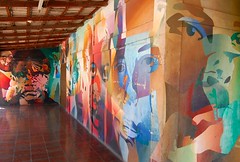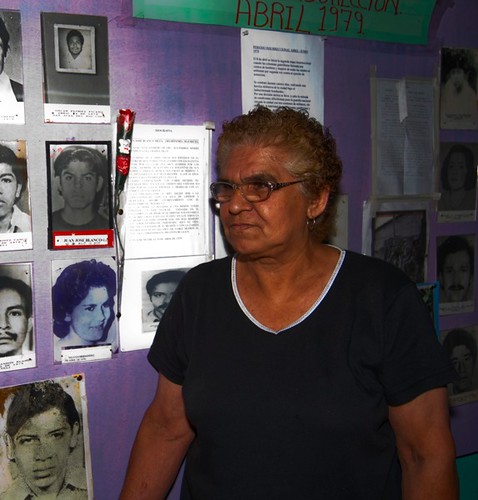
A visit to the Gallery of Heroes and Martyrs of the Revolution, and a conversation with Nina, a Sandinista veteran combatant.
You cannot take this as just another wayside attraction. The gallery is, of course, one of the main ‘things to do’ for tourists visiting Esteli – a purpose-built gallery with things to look at and read, and a history to peruse. The brightly coloured mural adorning two outside walls greets you with a semi-psychedelic invitation to ‘decode’ the faces and figures superimposed one over the other. This is the bright side of the Gallery. Inside is the story of a 64-year people’s struggle against US Imperialism and Fascist dictatorship starting with General Sandino’s uprising against US Marines stationed in Nicaragua to impose US policy and ending with the fizzling out of Reagan’s narcotic and arms funded 1980s Contra War against the victorious Sandinistas who had won the revolution against the dictators in 1979.

The story is illustrated with photographs of those who died fighting and of bands of Sandinista combatants in training or fighting behind barricades.
Over an hour of silent perusal leaves one affected by the bravery, passion and commitment of those who risked and lost their lives to fight oppression. But this is only a tiny part of the story. The faces, the clothes and the biographies of the deceased, as well as poems by one poet, do leave you amazed at how people could gather the bravery to fight the National Guard in the streets. But…there is so much more to know and understand of personal stories.
In steps Nina, getting water to make lunch for other women veterans of the revolution. Eye contact, a smile and an invitation to talk lead quickly on to the discovery of something of what it was like for an individual to live and fight through the 1970s.

Nina in front of photographs of those who lost their lives fighting for freedom. Her two sons are top left and bottom left.
She was a guerrilla from Esteli who was based in the mountains, leaving her two sons and three daughters to oppose the dictator in the town. Her serious expression, strong posture and large, working hands suggest a woman of substance, who has worked hard in the past. As indeed she has; having risked her life, endured danger and lost people close to her for a strongly held cause. She tells us of the three insurrections in town between 1978 and 1979. Of small groups of combatants, the displays mention on insurrection being led by 24 people, being joined by ordinary people in the town to fight the National Guard. Of how her group came down from the nearby mountains to attack National Guard targets based in town. Of how the women of the town helped the combatants by giving secret signals from their houses to invite the Sandinistas in for food and drink, which gave the guerrillas the strength to fight on and on. She talks with passion, eyes alive with memories and desire to teach gringos about the struggle. Of course she had to take up arms. No one could sit back and watch while people around her starved, could not write for want of education or were ill from lack of health care.
She describes the joy when eventually, in September 1979, the Sandinistas defeated the National Guard in Esteli causing Somoza to flee the country. They had won, one of the handful of true people’s revolutions in the world. She twinkles as she tells us how they fired their rifles in the air in celebration while people of all ages came back out on to the streets banging pots and pans. But all around were the bodies of the dead, who they had to bury somewhere with the danger of sporadic firing from the National Guard piercing the streets. When families could identify bodies they reclaimed them, where they couldn’t they buried the dead together in large graves, often under the floors of houses.
Her regrets are that for 16 years following elections right-wing governments kept power and have impoverished the country further. She claims the country is poorer that it was in the 70s, that there is worse education and less land for people. She feels that the days of the struggle were better than today, perhaps the nostalgia of one who fought with others for a cause and had difficulty knowing what her life was about subsequently, especially so given the right-wing governments that followed the eventual end of Reagan’s Contra War. She hopes that the current Sandinista government of Ortega has long enough in power to begin to right the severe problems.
We leave after taking a photograph of her, which she insists is by the photographs of her two sons killed by the National Guard, and many thank yous and hugs. She is clearly pleased there are foreigners who want to learn about the difficulties and ultimate success of the Sandinista revolution.



No comments:
Post a Comment